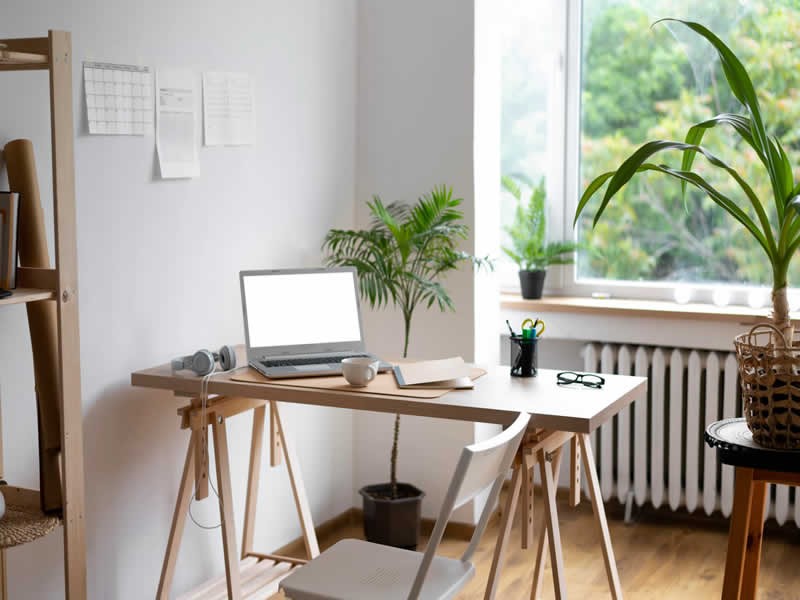Insight Blog
Agility’s perspectives on transforming the employee's experience throughout remote transformation using connected enterprise tools.
9 minutes reading time
(1716 words)
How much space do you need behind a desk?
Work from home? We tell you how to set up a home office— How much space do you need behind a desk? For an efficient and comfortable workspace
Whether you're working out of a home office or a commercial space, you need adequate room to spread out and be comfortable. Whether or not you leave enough room in crucial spots can make or break your working experience.
The desk's arrangement and available space behind the desk is a crucial factors to think about. There needs to be plenty of room to walk around and set up necessary things such as seats, cabinets, bookcases, etc.
Keep on reading to know how much space you should leave behind a desk.
Required space behind a desk
When it comes to the best layout for a workspace, having the correct amount of required space behind a desk is essential for a productive work environment.
Ideally there should be enough room for one to move and adjust their chair without feeling restricted, but not so much that it becomes an obstruction or impedes workflow. Working from home can often come with challenges when creating this balance, as homeowners commonly have less space to work with than in traditional office settings.
However, if planned properly, having at least 48 inches of free space behind a desk will allow the worker enough freedom of movement while ensuring the efficient use of their limited area.
Putting your desk up against a wall can help you make the most efficient use of the available space. When planning a home office's layout, it's important to first evaluate how your requirements compare to the available space.
Considering the typically lower size of remote offices, this could be quite essential for a home office.
How much room you need between your desk and the wall might be influenced by the following factors.
Important factors to consider when placing the desk near a wall
You will have to shift your chair to leave your office. Your chair needs to be able to move freely behind your desk without hitting a wall or other obstacles.
Normal chairs need at least 23–25 inches of space from the end of the desk to the nearest wall or piece of furniture. But this isn't enough for a large, ergonomic office chair. There should be at least 30 to 32 inches of room behind your desk in this situation.
Still, we're not big fans of doing without. We recommend leaving 38 to 40 inches of clear space between the end of your desk and any other furniture if you do have extra room.
You'll have extra room to work in and be able to adjust how your chair is positioned at the desk.
Finally, you should think about whether or not you need to leave room behind you so that another person can move even while you are working.
There is less of a chance of this happening at a home office, but if it does, make sure there are at least 18 inches of empty desk space behind your chair.
When your desk is facing the wall
Whether or not you face the wall while seated depends on the side of the room, you're in. Leave some distance between yourself and the wall if you are facing a window to mitigate the effects of direct sunlight. If your office door is situated behind a wall, you should reposition your desk so that it doesn't obstruct the doorway.
But if you're up against a wall without any openings, think about whether or not you'd benefit by leaving a space. At least three to four feet of space is needed between the wall and the desk while you are seated with your back to the wall.
A similar amount of room is required for placing a bookcase, drawer, or cabinet that is 10 to 12 inches deep behind the chair. In this configuration, you'll need at least 6 or 7 feet of space, which could move your workstation closer to or farther from the middle of the room.
In a cramped space like a 10' by 10' office, this may be a major problem. Instead, clear the middle of the room by moving your desk towards the wall and sitting in front of it. Put the shelves, drawers, or cupboards on the other wall.
When your desk is behind the door
If you want to create more privacy in your office, you can put a desk behind a closed door, but make sure there isn't too much room between the desk and the door. You shouldn't have to squirm out of the way of your desk every time the door opens or closes at work.
First, to avoid this issue altogether, you should relocate your workstation such that it is against the wall across from the door. If your desk is placed against a wall, you'll need to determine if you'll want some breathing room there. Leave at least 4–6 feet of space for the chair and for walking about when seated with your back to the wall.
When your desk is in front of the window
It is recommended to have at least three feet of space between the workstation and the wall in order to avoid uncomfortable glare. Though natural light is great for illuminating a workspace, it can also cause eye strain and cause electronic gadgets to overheat.
If you cannot move your workstation away from a window, consider getting some drapes or curtains to block the harsh sunlight during the day.
It's not a good idea to put your back to the window while watching TV, as the reflection of the glass could potentially harm your eyes. Screen glare will be exacerbated by the sun's brightness and grow worse the longer you're outside.
How much space do you need behind a desk in a non-office setting?
Not everyone has the financial means to dedicate an entire room as a workplace at home. The bedrooms of distant workers come in second, followed by strange places like under the stairs and in the hallway. Therefore, the arrangement of the room will determine if there should be any clearance between the desk and the wall.
Placing the desk in the bedroom
Many people who work remotely said that their bedroom serves as their office. One of the best places to set up shop at home is in a bedroom, but it's important to avoid distractions by not allowing too much area between your workstation and the wall. Having extra space in a crowded bedroom is unlikely. If you want to set up a workstation in your bedroom, you should give yourself at least two or three feet of clearance between the desk and the bed, and the door. This will make it simple to get in and out of your chair at the office desk.
Placing the desk in the living room
The living room provides a lot of options for arranging a desk, making it a good candidate for conversion into a home office. However, the arrangement and furnishings should be considered. Maintain a free 3-foot radius around your desk to facilitate easy movement.
Numerous pieces of furniture in a living room could make it impossible to install a dedicated office space. Adding one may limit motion even if it is possible. Depending on the desk's size and the available floor space, you may be able to leave some distance between it and the wall.
What should be the size of your office desk?
Since you'll be purchasing it for an indefinite period of time, a desk with a width of at least 610mm is a must. You won't get much use out of it if you reduce its size. It's important to give some thought to the location of your desk, the items you'll need to keep on it, and the frequency with which you'll be using it.
Your workstations may need to be a little bit wider if you want to use them for long periods of time. If you're short on room in your office, a smaller desk and a filing cabinet or storage pedestal that sits at desk height are both good options.
How much space should you leave between the desk and upper cabinets?
We suggest you move the desk to a different location if you intend to add overhead cabinets in your office. Because it can get a little cramped having higher cabinets so near to your desk.
If, however, you can't find a better spot for them and must mount them over your desk, you should give some thought to how much vertical clearance you have. That's the distance between those two furniture items.
Upper cabinets are typically between 34 and 36 inches tall, while desks are around 30 inches. There must be at least 18 inches of vertical clearance between them.
How can you fill the gap between the desk and the wall?
Smaller items often roll down the gap between the wall and the desk, no matter how small it is. Space dividers can be used to conceal the void between your workstation and the wall. The void can be used to store cable organizers under the desk.
Small gaps can be temporarily patched with tape, while larger ones can be covered with a similarly colored hardwood board that doubles as a desk extension.
Add some furniture or decoration to the empty space. Bookshelves, cabinets, potted plants, and other ornamental items all fit this description. Keep in mind the gap's size, the objects you intend to utilize to fill it, and the room's overall design and aesthetic while making your decision.
Wrapping
Depending on your situation, free space, and home office design, you may or may not want to free up the area behind your desk. Having a space of a few inches to reach for dropped items is helpful. If you don't want to be confined to a tiny space, make sure there's enough room to walk around your desk and the wall.
Categories
Blog
(2594)
Business Management
(318)
Employee Engagement
(206)
Digital Transformation
(172)
Intranets
(119)
Growth
(118)
Remote Work
(61)
Sales
(48)
Collaboration
(37)
Culture
(29)
Project management
(29)
Customer Experience
(26)
Knowledge Management
(21)
Leadership
(20)
Comparisons
(5)
Ready to learn more? 👍
One platform to optimize, manage and track all of your teams. Your new digital workplace is a click away. 🚀
Free for 14 days, no credit card required.















